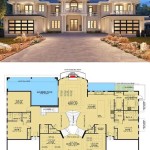Floor Plan Of Your House: A Detailed Guide To Create Your Own Design
Creating a floor plan is the fundamental step in designing or renovating a house. A well-crafted floor plan provides a visual representation that maps out the spatial relationships between rooms, circulation patterns, and the placement of key elements like doors, windows, and fixtures. It acts as a blueprint for construction, ensuring that the final product aligns with the homeowner's needs and aesthetic preferences. This detailed guide provides comprehensive instructions on developing a floor plan for a house, covering essential considerations and practical techniques.
Before embarking on the actual drafting process, meticulous planning is crucial. This involves defining the scope of the project, assessing needs, and gathering necessary information. A poorly planned floor plan can lead to inefficiencies in space utilization, awkward room arrangements, and ultimately, dissatisfaction with the built environment.
Defining the Project Scope and Requirements
The initial step requires defining the purpose of the floor plan. Is it for a new construction project, a minor renovation, or a complete overhaul? Understanding the project scope helps in setting realistic goals and expectations. For new constructions, one must consider the zoning regulations, building codes, and any restrictions imposed by the local authorities. Renovations, on the other hand, need to account for the existing structure, including load-bearing walls, plumbing, and electrical systems. The scope also dictates the level of detail required in the floor plan. A simple renovation might only require outlining the changes to a specific room, while a new construction necessitates a comprehensive plan encompassing the entire house.
In addition to the project scope, gathering requirements involves creating a detailed inventory of the homeowner's spatial needs and preferences. This includes determining the number of bedrooms and bathrooms desired, the size and function of living spaces (e.g., living room, dining room, home office), and any specific features such as a home theater, gym, or in-law suite. Consider the lifestyle of the occupants. For instance, a family with young children might prioritize a large, open-plan living area, while individuals who work from home might require a dedicated office space with ample storage. The requirements should also take into account accessibility considerations for elderly or disabled family members. This could include wider doorways, ramps, and grab bars in bathrooms.
Furthermore, consider the budget allocated to the project. This will influence the size and complexity of the house, the materials used, and the level of customization possible. Establishing a realistic budget early on helps to avoid cost overruns and ensures that the design remains within financial constraints.
Measuring and Documenting Existing Conditions
For renovation projects, accurate measurements of the existing structure are paramount. This includes measuring the dimensions of each room, the height of ceilings, and the location of windows, doors, and structural elements like walls and columns. Documenting these measurements is best achieved using a laser distance measurer, which provides high accuracy and reduces the risk of errors. Alternatively, a traditional measuring tape can be used, but extra care should be taken to ensure measurements are precise.
Begin by creating a rough sketch of the existing floor plan on graph paper or using a digital sketching tool. Take detailed measurements of each room and record them on the sketch. Pay attention to the thickness of walls, the location of electrical outlets and switches, and the position of plumbing fixtures. Capture the location and dimensions of all doors and windows, including their height from the floor. Additionally, note the direction in which doors swing open, as this can impact furniture placement and circulation patterns.
It is highly recommended to photograph each room from multiple angles. This provides a visual record of the existing conditions and helps to identify any features or issues that might not be immediately apparent during the measurement process. Include close-up shots of significant details such as moldings, built-in cabinets, and any existing damage or defects. These photographs can be invaluable during the design process and can assist in making informed decisions about the renovation.
For both new construction and renovation projects, it is essential to obtain a copy of the property survey or site plan. This document provides information about the property boundaries, easements, and any existing structures or features on the site. The survey also indicates the location of utilities such as water lines, sewer lines, and electrical cables, which must be considered when planning the layout of the house.
Utilizing Design Tools and Principles
Once the project scope is defined and the existing conditions are documented, the next step involves creating the floor plan itself. Several tools and principles can be employed to ensure the design is both functional and aesthetically pleasing.
There are several software options available for creating floor plans, ranging from free online tools to professional-grade CAD (Computer-Aided Design) software. For simple projects, online tools like Planner 5D or Floorplanner can be sufficient. These tools offer user-friendly interfaces and allow to create basic floor plans with drag-and-drop features. They also often include libraries of furniture and fixtures that can be used to visualize the space.
For more complex projects, CAD software such as AutoCAD, Revit, or SketchUp offer greater precision and flexibility. These programs allow to create detailed floor plans with accurate dimensions and to generate 3D models of the house. While CAD software requires a higher learning curve, it provides the capabilities to create professional-quality drawings that can be shared with contractors and other stakeholders.
Regardless of the tool chosen, several design principles should be considered when creating the floor plan. These include:
*Functionality: The floor plan should facilitate the day-to-day activities of the occupants. Consider the flow of traffic between rooms and ensure that frequently used spaces are easily accessible. The layout should also accommodate the storage needs of the family, with adequate closet space and storage areas.
*Privacy: Carefully consider the placement of bedrooms and bathrooms to ensure adequate privacy. Separate these spaces from high-traffic areas such as the living room and kitchen. Consider using soundproofing materials to minimize noise transmission between rooms.
*Natural Light and Ventilation: Maximize the use of natural light and ventilation by strategically placing windows and doors. Orient the house to take advantage of sunlight exposure and prevailing winds. Large windows can bring ample light into the interior, while operable windows provide natural ventilation. Consider the use of skylights to illuminate interior spaces that do not have access to exterior walls.
*Circulation: Design circulation paths that are clear and efficient. Avoid creating hallways that are too narrow or that lead to dead ends. Ensure that there is adequate space for people to move freely between rooms without obstruction.
*Scale and Proportion: Pay attention to the scale and proportion of rooms and furnishings. Ensure that furniture fits comfortably within the space and that there is adequate space for movement around furniture. Avoid creating rooms that are too large or too small in proportion to the overall size of the house.
During the design process, create multiple iterations of the floor plan and experiment with different layouts. Seek feedback from family members or other stakeholders to identify potential issues and refine the design. It is often helpful to create a 3D model of the house to visualize the space and identify any potential problems before construction begins.
In addition to the overall layout, attention should be paid to the specific details of each room. In the kitchen, consider the placement of appliances, countertops, and storage spaces. The "work triangle" – the relationship between the sink, refrigerator, and stove – is a key factor in kitchen design. In the bathroom, consider the placement of the toilet, sink, and shower or bathtub. Ensure that there is adequate space for movement and storage. In the bedrooms, consider the placement of the bed, dresser, and closet. Provide ample space for walking around the bed and ensure that there is adequate closet space for clothing and personal items.
The development of a floor plan is an iterative process that requires careful planning, attention to detail, and a thorough understanding of design principles. By following the steps outlined in this guide, homeowners can create a floor plan that meets their needs and preferences, ensuring a successful and satisfying construction or renovation project. A well-designed floor plan is an investment that will pay dividends in the form of a comfortable, functional, and aesthetically pleasing living space.

Create Floor Plan

Create House Plans All In One Roomsketcher

Create House Plans All In One Roomsketcher

Floor Plans Learn How To Design And Plan

Floor Plan Design Tutorial Youtube

How To Draw Blueprints For A House With Pictures Wikihow

How To Draw Accurate Floor Plans Step By Guide

Create House Plans All In One Roomsketcher

Floor Plans Learn How To Design And Plan

Create House Plans All In One Roomsketcher
Related Posts








